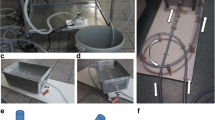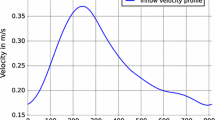Abstract
The quality of visualization in inflow magnetic resonance angiography (MRA) depends highly on the excitation state of the longitudinal magnetization obtained using specified imaging parameters. In addition, signal intensity changes controlled by the preparation pulse—such as inversion recovery (IR) and saturation recovery (SR)—can potentially be used as quantitative physiological values. Although having practitioners understand these relationships both qualitatively and quantitatively is important, handling clinical equipment in practical learning or experiments involves limited opportunities. The simulator corresponds to a three-dimensional spoiled gradient echo sequence and allows users to freely input multiple virtual excitation effects in space and time. The purpose of this study was to quantitatively evaluate the agreement between the measured MRAs obtained in flow phantom tests and virtual MRAs simulated under similar conditions. We imaged two vascular flow phantoms on a 3.0 T MR system using three-dimensional (3D) time-of-flight (TOF) MRA and 3D inversion recovery tissue signal suppression (IR-suppression) MRA protocols. We evaluated quantitative values for consistency between the measured and virtual MRAs images with matched spatial resolution. Then we assessed the coincidence by reformatting maximum-intensity projection images with 1 mm isotropic pixels, with it ranging from 89.6 to 92.0% and 89.1 to 92.9% for TOF MRA and IR-suppression MRA, respectively. These results may be useful as a reference index for the theoretical study of MRA images by practitioners, for complementary validation by phantom testing, or for the development of MRI-related simulators.





Similar content being viewed by others
References
Rick M, Kaarmann N, Weale P, et al. How I do it: non contrast-enhanced MR angiography (syngo NATIVE). MAGNETOM Flash. 2009;3:18–23.
Shimada K, Isoda H, Okada T, et al. Non-contrast-enhanced MR portography with time-spatial labeling inversion pulses: comparison of imaging with three-dimensional half-fourier fast spin-echo and true steady-state free-precession sequences. J Magn Reason Imaging. 2009;29:1140–6.
Wu H, Block WF, Turski PA, et al. Noncontrast dynamic 3D intracranial MR angiography usisng pseudo-continuous arterial spin labeling (PCASL) and acerated 3D radial acquisition. J Magn Res Imaging. 2014;39:1320–6.
Nakamura M, Yoneyama M, Tabuchi T, et al. Vessel-selective, non-contrast enhanced, time-resolved MR angiography with vessel-selective arterial spin labeling technique (CINEMA-SELECT) in intracranial arteries. Radiol Phys Technol. 2013;6:327–34.
Ikushima I, Korogi Y, Hirai T, et al. Variable tip angle slab selection pulses for carotid and cerebral time-of-flight MR angiography. Acta Radiol. 1997;38:275–80.
Jou LD, van Tyen R, Berger SA, et al. Calculation of the magnetization distribution for fluid flow in curved vessels. Magn Res Med. 1996;35:577–84.
Jou LD, Saloner D. A numerical study of magnetic resonance images of pulsatile flow in a two dimensional carotid bifurcation. Med Eng Phys. 1998;20:643–52.
Lorthois S, Stroud Rossman J, Berger S, et al. Numerical simulation of magnetic resonance angiographies of an anatomically realistic stenotic carotid bifurcation. Ann Biomed Eng. 2005;33:270–83.
Segur JB, Oberstar HE. Viscosity of glycerol and its aqueous solutions. Ind Eng Chem. 1951;47:2117–20.
Zhao M, Hanjani SA, Ruland S, et al. Regional cerebral blood flow using quantitative MR angiography. AJNR AM J Neuroradiol. 2007;28:1470–3.
Atkinson D, Brant-Zawadski M, Gillan G, et al. Improved magnetic resonance angiography: magnetization transfer suppression with variable flip angle excitation and increased resolution. Radiology. 1994;190:890–4.
OpenCFD, OpenFOAM User Guide version 2.3.0, OpenCFD Ltd. 2014.
Weingärtner H. Self-diffusion in liquid water. A reassessment. Z Phys Chem. 1982;132:129–49.
Shuichi Y. Diffusion coefficients as mass transfer properties and water ad/desorption (drying). Jpn J Food Eng. 2010;11(2):73–83.
The Open CAE Society of Japan. Numerical analysis of heat transfer and flow using OpenFOAM. OpenFOAM ni yoru netsuidou to nagare no suuchikaiseki (in Japanese). 2016; 128–136. Morikita Shuppan.
Fortin A, Salmon S, Baruthio J, Delbany M, Durand E. Flow MRI simulation in complex 3D geometries: application to the cerebral venous network. Magn Reson Med. 2018;80(4):1655–65. https://doi.org/10.1002/mrm.27114 (Epub 2018 Feb 5 PMID: 29405357).
Tamura H, et al. T1 measurements with clinical MR units. Tohoku J Exp Med. 1995;175(4):249–67. https://doi.org/10.1620/tjem.175.249.
Cernicanu A, Axel L. Theory-based signal calibration with single-point T1 measurements for first-pass quantitative perfusion MRI studies. Acad Radiol. 2006;13:686–93.
Hackländer T, Mertens H. Virtual MRI: A PC-based simulation of a clinical MR scanner1. Acad Radiol. 2005;12(1):85–96.
Kita M, Sato M, Kawano K, Kometani K, Tanaka H, Oda H, Kojima A, Tanaka H. Online tool for calculating null points in various inversion recovery sequences. Magn Reson Imaging. 2013;31(9):1631–9.
Tatsunori SAHO. Study of hemodynamic analysis employing computational fluid dynamics. Jpn J Imaging Inf Sci Med. 2014;31(2):xxxvi–xxxviii.
Omodaka S, Inoue T, Funamoto K, et al. Influence of surface model extraction parameter on computational fluid dynamics modeling of cerebral aneurysms. J Biomech. 2012;45:2355–61.
Haacke EM, Lenz GW. Improving MR image quality in the presence of motion by using rephasing gradients. AJR Am J Roentgenol. 1987;148:1251–8.
Liebeskind DS, Kosinski AS, Lynn MJ, et al. Noninvasive fractional flow on MRA predicts stroke risk of intracranial stenosis. J Neuroimaging. 2015;25:87–91.
Ibrahim AY, Amirabadi A, Shroff MM, Dlamini N, Dirks P, Muthusami P. Fractional flow on TOF-MRA as a measure of stroke risk in children with intracranial arterial stenosis. Am J Neuroradiol. 2020;41(3):535–41.
Han K-S, Lee SH, Ryu HU, Park S-H, Chung G-H, Cho YI, Jeong S-K. Direct assessment of wall shear stress by signal intensity gradient from time-of-flight magnetic resonance angiography. BioMed Res Int. 2017;2017:1–8.
Zun Z, Wong EC, Nayak KS. Assessment of myocardial blood flow (MBF) in humans using arterial spin labeling (ASL): feasibility and noise analysis. Magn Reson Med. 2009;62:975–83.
Kober, et al. Myocardial arterial spin labeling. J Cardiovasc Magn Reson. 2016;18:22. https://doi.org/10.1186/s12968-016-0235-4.
Uesugi N, Nagata M. Pathlogy of vasculitis. Nihon Jinzo Gakkai shi. 2014;56:87–97.
Wenterhof N, Lankhaar J-W, Westerhof BE. The arterial Windkessel. Med Biol Eng Comput. 2009;47:131–41.
Author information
Authors and Affiliations
Corresponding author
Ethics declarations
Conflict of interest
The authors declare that they have no conflict of interest.
Ethical approval
This article does not contain any studies performed with human participants.
Additional information
Publisher's Note
Springer Nature remains neutral with regard to jurisdictional claims in published maps and institutional affiliations.
Supplementary Information
Below is the link to the electronic supplementary material.
About this article
Cite this article
Hatakeyama, N., Kobayashi, S. Development and practical evaluation of a saturation effect learning simulator for inflow magnetic resonance angiography. Radiol Phys Technol 15, 311–322 (2022). https://doi.org/10.1007/s12194-022-00671-5
Received:
Revised:
Accepted:
Published:
Issue Date:
DOI: https://doi.org/10.1007/s12194-022-00671-5




